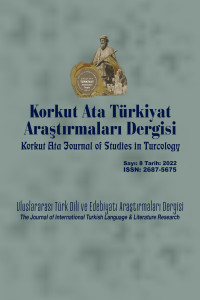Öz
Sezai Karakoç, who is one of the important figures of contemporary Turkish literature, is a person who has come to the fore with his thought that aims to rise again in all areas of life and expresses this aim with the concept of “resurrection”. The fall of man and civilization has a special meaning in Karakoç’s world of thought, as the resurrection evokes the opposite of phenomena such as decline and collapse. The collapse of the Andalusian civilization, which is considered one of the bright pages of Islamic history, is one of the main issues that is constantly on the agenda of the thinker, as one of the striking examples of the decline. One of the concrete examples of his interest in the region and its collapse is the translation of the Andalusian elegy (Ratha al-Andalus poem) by Abu al-Baqa al-Rundi, one of the famous poets of the thirteenth century, into Turkish in verse with the title of Lament for Andalusia. In this article, Karakoç’s translation is discussed in comparison with the Arabic text of the eulogy, and it is evaluated in terms of scientific and literary terms. Our study aims both to determine where the translation stands against other translations of the eulogy and to shed light on the question of whether a poem translation written by a poet will have different characteristics from the texts put forward by translators who do not have this qualification.
Anahtar Kelimeler
Kaynakça
- Arslan, E. Ş. (2014). el-Hulelü’s-sündüsiyyetü fi’l-ahbâri ve’l-âsâri’l-Endelüsiyye. Kahire: Müessesetü Hindâvî.
- Dayf, Ş. (1987). er-Risâ. Kahire: Dâru’l-Maârif.
- Fayda, M. (2009). Seyf b. Zûyezen. Türkiye Diyanet Vakfı İslam Ansiklopedisi (C. 37, s. 29-30). İstanbul: TDV Yayınları.
- Halîfe, A. (1994). Ebü’l-Bekā er-Rundî. Türkiye Diyanet Vakfı İslam Ansiklopedisi (C. 10, s. 298-299). İstanbul: TDV Yayınları.
- Harman, Ö. F. (2000). İrem. Türkiye Diyanet Vakfı İslam Ansiklopedisi (C. 22, s. 443). İstanbul: TDV Yayınları.
- Karakoç, S. (2000). İslâmın Şiir Anıtlarından Çeviriler. İstanbul: Diriliş Yayınları.
- Karakoç, S. (2009). Fizikötesi Açısından Ufuklar ve Daha Ötesi III Doğum Işığı. İstanbul: Diriliş Yayınları.
- Karakoç, S. (2011). Sütun Günlük Yazılar II. İstanbul: Diriliş Yayınları.
- Kaya, M. (2000). İskender. Türkiye Diyanet Vakfı İslam Ansiklopedisi (C. 22, s. 555-557). İstanbul: TDV Yayınları.
- Kaya, M. (2018). İslâmî Edebiyatta Şaheserler. İstanbul: Türkiye Yazma Eserler Kurumu Başkanlığı Yayınları.
- Konrapa, M. Z. (1964). Endülüs Mersiyesi-Niẓâmî Tercümesi ve Endülüs Târihine Kısa Bir Bakış. İstanbul Yüksek İslâm Enstitüsü Dergisi, 2, 165-184.
- Şevkî, A. (2011). eş-Şevkiyyât. Kahire: Müessesetü Hindâvî.
- Timurtaş, A. (2015). Bir Şehir Mersiyesi Örneği: Ebu’l-Bekâ er-Rundî’nin Endülüs Mersiyesi. Uluslararası Sosyal Araştırmalar Dergisi, 8(36), 217-229.
- Topaloğlu, B. & Karaman, H. (2017). Arapça Okuma ve Eski Metinler Kitabı. İstanbul: Ensar Neşriyat.
- Ubûdî, C. (2001). İşbîliye. Türkiye Diyanet Vakfı İslam Ansiklopedisi (C. 23, s. 428-429). İstanbul: TDV Yayınları.
Öz
Çağdaş Türk edebiyatının önemli simalarından Sezai Karakoç, hayatın tüm alanlarında yeniden yükselişi hedefleyen ve “diriliş” kavramında ifadesini bulan düşüncesiyle öne çıkmış bir şahsiyettir. Diriliş, zıddı olan düşüş, çöküş gibi olguları çağrıştırdığı için, Karakoç’un fikir dünyasında insanın ve medeniyetin düşüşü de özel bir anlama sahiptir. İslâm tarihinin parlak sayfalarından sayılan Endülüs medeniyetinin çöküşünün, düşüşün çarpıcı örneklerinden biri olarak mütefekkirin gündeminde sürekli yer aldığı bilinmektedir. Miladî on üçüncü asrın meşhur şairlerinden Ebü’l-Bekā Sâlih b. Şerîf er-Rundî’ye ait Endülüs mersiyesini (Risâu’l-Endelüs) Endülüs’e Ağıt başlığıyla manzum olarak Türkçeye çevirmesi, onun, bölgeye ve çöküşüne yönelik ilgisinin somut örneklerinden birini teşkil etmektedir. Bu makalede, Karakoç’un mezkûr çevirisi, kasidenin Arapça metniyle mukayeseli olarak ele alınmakta, ilmî ve edebî açıdan değerlendirmeye tabi tutulmaktadır. Çalışma, hem çevirinin, kasidenin diğer tercümeleri karşısında durduğu yeri tespit etmeyi hem de bir şairin kaleminden çıkan şiir çevirisinin, bu vasfa sahip olmayan mütercimlerin ortaya koyduğu metinlerden farklı özelliklere sahip olup olmayacağı sorusuna ışık tutmayı hedeflemektedir.
Anahtar Kelimeler
Kaynakça
- Arslan, E. Ş. (2014). el-Hulelü’s-sündüsiyyetü fi’l-ahbâri ve’l-âsâri’l-Endelüsiyye. Kahire: Müessesetü Hindâvî.
- Dayf, Ş. (1987). er-Risâ. Kahire: Dâru’l-Maârif.
- Fayda, M. (2009). Seyf b. Zûyezen. Türkiye Diyanet Vakfı İslam Ansiklopedisi (C. 37, s. 29-30). İstanbul: TDV Yayınları.
- Halîfe, A. (1994). Ebü’l-Bekā er-Rundî. Türkiye Diyanet Vakfı İslam Ansiklopedisi (C. 10, s. 298-299). İstanbul: TDV Yayınları.
- Harman, Ö. F. (2000). İrem. Türkiye Diyanet Vakfı İslam Ansiklopedisi (C. 22, s. 443). İstanbul: TDV Yayınları.
- Karakoç, S. (2000). İslâmın Şiir Anıtlarından Çeviriler. İstanbul: Diriliş Yayınları.
- Karakoç, S. (2009). Fizikötesi Açısından Ufuklar ve Daha Ötesi III Doğum Işığı. İstanbul: Diriliş Yayınları.
- Karakoç, S. (2011). Sütun Günlük Yazılar II. İstanbul: Diriliş Yayınları.
- Kaya, M. (2000). İskender. Türkiye Diyanet Vakfı İslam Ansiklopedisi (C. 22, s. 555-557). İstanbul: TDV Yayınları.
- Kaya, M. (2018). İslâmî Edebiyatta Şaheserler. İstanbul: Türkiye Yazma Eserler Kurumu Başkanlığı Yayınları.
- Konrapa, M. Z. (1964). Endülüs Mersiyesi-Niẓâmî Tercümesi ve Endülüs Târihine Kısa Bir Bakış. İstanbul Yüksek İslâm Enstitüsü Dergisi, 2, 165-184.
- Şevkî, A. (2011). eş-Şevkiyyât. Kahire: Müessesetü Hindâvî.
- Timurtaş, A. (2015). Bir Şehir Mersiyesi Örneği: Ebu’l-Bekâ er-Rundî’nin Endülüs Mersiyesi. Uluslararası Sosyal Araştırmalar Dergisi, 8(36), 217-229.
- Topaloğlu, B. & Karaman, H. (2017). Arapça Okuma ve Eski Metinler Kitabı. İstanbul: Ensar Neşriyat.
- Ubûdî, C. (2001). İşbîliye. Türkiye Diyanet Vakfı İslam Ansiklopedisi (C. 23, s. 428-429). İstanbul: TDV Yayınları.
Ayrıntılar
| Birincil Dil | Türkçe |
|---|---|
| Konular | Sanat ve Edebiyat, Edebi Çalışmalar |
| Bölüm | Araştırma Makaleleri |
| Yazarlar | |
| Yayımlanma Tarihi | 30 Ağustos 2022 |
| Gönderilme Tarihi | 24 Temmuz 2022 |
| Yayımlandığı Sayı | Yıl 2022 Sayı: 8 |

